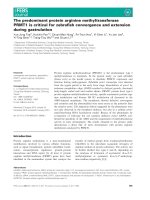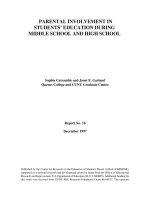For business college and life Effective writing pdf
Bạn đang xem bản rút gọn của tài liệu. Xem và tải ngay bản đầy đủ của tài liệu tại đây (1.38 MB, 134 trang )
Copyright © 2005 by William R. Stanek. All rights reserved,
including the right to reproduce this book, or portions thereof, in
any form. No portion of this book may be reproduced or
transmitted in any form or by any means without express written
permission of the publisher. Printed in the United States of
America.
Reagent Press
Cover design & illustration by William R. Stanek
ISBN 1-57545-819-5
Microsoft, MS-DOS, and Windows are either registered
trademarks or trademarks of Microsoft Corporation in the United
States and/or other countries. Intel is a registered trademark of
Intel Corporation. Other products mentions herein may be the
trademarks of their respective owners.
Any characters, names, places and events portrayed in this book
are either products of the author's imagination or are used
fictitiously. Any resemblance to any actual locale, person or event
is entirely coincidental. While every precaution has been taken in
production of this book, the publisher assumes no responsibility
for errors or omissions, or for damages resulting from the use of
the information contained herein.
Table of Contents
PART I: GETTING ORGANIZED 7
CHAPTER 1: BUILDING BLOCKS FOR
EFFECTIVE WRITING 9
Managing Expectations 10
Managing Perceptions 11
Managing Strategies 12
Managing Goals 14
Managing Rules 14
Managing Behavior 15
CHAPTER 2: IMPROVING IDEAS:
TECHNIQUES TO BETTER ORGANIZE 17
Brainstorming Techniques 18
Freethinking Techniques 20
Storyboarding Techniques 20
CHAPTER 3: EFFECTIVE STRATEGIES FOR
PLANNING AND ORGANIZATION 23
Composition Processes 23
Development Processes 29
Pre-Finalization Processes 36
Combining It All 41
CHAPTER 4: TECHNIQUES TO GET STARTED
43
Setting a Schedule 43
Connecting Milestones and Goals 45
CHAPTER 5: TECHNIQUES TO ORGANIZE
FOR THE AUDIENCE 47
Defining the Audience 47
Seeing With the Reader's Eyes 48
Gathering Statistics 49
Evaluating Trends 50
4 / Effective Writing
CHAPTER 6: ORGANIZING THROUGH
STORYBOARDING 53
Working with Storyboards 53
Developing Structure Using Storyboards 56
Developing Content Using Storyboards 59
Evaluating Storyboard Organization 61
PART I: QUICK REVIEW 63
PART II: PAGE DESIGN 67
CHAPTER 7: DESIGNING WITH SPACE 69
Using Space Effectively 69
Sizing Your Paragraphs 69
Adding Graphics 70
CHAPTER 8: UNDERSTANDING COLOR 73
What Does Color Represent? 73
Using Color in Presentations 74
CHAPTER 9: POWERFUL HEADINGS 77
Headings: Best Uses 77
Good Headings vs. Bad Headings 78
CHAPTER 10: EXPLORING FONTS 79
Working with Fonts 79
Deciding Which Font to Use 80
CHAPTER 11: UNLEASHING PAGE LAYOUT 85
How Graphic Designers Use Grids 85
Text Components in Page Design 86
Graphic Components in Page Design 87
PART II: QUICK REVIEW 89
PART III: TAPPING INTO THE POWER OF
MULTIMEDIA 91
CHAPTER 12: MULTIMEDIA BONANZA 93
What is MPEG? 94
Considerations to Make Before Adding Multimedia 98
William R. Stanek / 5
Let's Talk Sound 99
Let's Talk Video 103
The Critical Question Of Resources 106
PART III: QUICK REVIEW 107
PART IV: DELIVERING YOUR WORK 109
CHAPTER 13: LAST MINUTE GOTCHAS 111
What to Look For when Proofing 111
Tips for Checking Spelling 114
Tips for Checking Grammar 118
How to Catch Typos Outside Main Text 125
How to Catch Inconsistencies 126
Balancing Perfection with Efficiency and Timeliness 128
PART IV: QUICK REVIEW 131
ABOUT THE AUTHOR 132
Part I:
Getting Organized
Blockbusters are not written, they are produced. Look at
today's hit movies and TV shows. Behind the big scenes, you
will find a producer and often a collaborative team. Print and
digital mediums are no exception.
Behind the big titles, you will find a team—editors, writers, and
designers. All these people help to organize ideas into a finely
polished work. They do this by collaborating—organizing their
ideas into a common structure through planning, revision,
polishing, and evaluation.
Even when creative works are the result of a single person's
efforts, the finished product is still a result of planning,
revision, polishing, and fretting over the organization of the
work. This is true even for creative people who claim never to
use outlines. The simple fact is, finely polished works do not
spring to the writer's pen, the painter's canvas, or the
musician's note sheets.
The best works are the result of effective strategies for
thinking, planning, and composing. Helping you create the best
work through effective strategies for thinking, planning, and
composing is precisely what this section is all about.
You will learn
Why organization is important
The building blocks for effective writing
Techniques to better organize and improve ideas
Effective strategies for planning and organization
Techniques to get started
Techniques to organize for the audience
8 / Effective Writing
Storyboards as an organization tool
Spending a few hours thinking about something that you may
spend months, or certainly days, working on makes sense.
Getting organized is extremely important, more so when you
are working in a new genre, medium or subject area.
Not only will good organization save you time, it will help you
produce a better final product. This is true regardless of
whether you plan to adapt existing works or create entirely new
works.
Chapter 1:
Building Blocks for Effective
Writing
Think of the creative process as a building process. Try to
build the roof of the house before you lay the foundation, and
you are going to have serious problems. Pour the concrete for
the foundation of the house before you put in the necessary
plumbing for water and sewer access, and you are going to
spend more money than you bargained for.
You build a house one step at a time. You ensure the house has
a strong foundation. Buildings with strong foundations tend to
weather the seasons and time. When you are almost done with
the frame of the house, you build a roof. Although the roof of
the house is the top of the structure, you do not stop there. It
takes more than a covered frame to make a house. You hire an
electrician to do the wiring and bring back the plumber to
finish the plumbing. Afterward, you hang plaster board, add
insulation, finish the exterior, add fixtures, and before you
know it, you have a house that you can call home.
You build your blockbuster in the same way, one step at a time.
The most important step is to stop treating your writing as an
article, story, book or report and start treating it as a project—
yeah, that's right, big picture baby! It's all about thinking large,
thinking different, and delivering your best. You are working
on a project—a project that follows the rules of any good
project and includes much more than simple writing.
Your start on the project is about as glamorous as the water
and sewer pipes waiting for the foundation to be poured
around them; for just when you are ready to roll back your
sleeves and dive into the project with both feet, you may
discover you need to conduct research, start planning, or
10 / Effective Writing
consider the requirements of the project. When you finally
flesh out the foundation of the project, you start to build the
framework.
The basic components of any writing are the pages that you
link together. These pages help you create chapters, articles and
columns. Even when you have completed the composing and
developing processes, the project still is not finished. You
check the structure of the work for flaws. You make sure you
have used the right mechanics and format. You examine the
fixtures. Once all this is done, you finally have a project worthy
of presenting to your colleagues, submitting to your professor,
or delivering to your editor.
Try to build the house all at once and you will be
overwhelmed. The same is true for any creative process. The
way you organize your thoughts can make the difference
between a successful project and a failed project. When you are
building your blockbuster, you need to manage many things.
Both on a level of general organization and a more specific
level tailored to the current project. This includes:
Expectations
Perceptions
Strategies
Goals
Rules
Behavior
Managing Expectations
If you mismanage expectations your project will fail. Your
expectations and the expectations of your editor, your boss, or
your professor may be totally different. Before you begin any
project, make sure your expectations and the expectations of
William R. Stanek / 11
those who will review the material mesh. A good way to do this
is to ensure that the communications channels are open and
used.
Discuss expectations from the beginning of the project.
Consider developing a rapid prototype of the project in which
you write a partial work geared toward the intended audience
and deliver this as a sample. If you develop a rapid prototype
of the project, your colleagues, peers or superiors should be the
ones to verify that it meets their expectations. If the prototype
does not meet their expectations, maybe the prototype was an
example of what not to do for this project, or maybe the
expectations were unrealistic.
You should also manage your personal expectations for the
project. Your expectations play a major role in the success or
failure of the project. The following is a list of do's and dont's
to help you manage expectations:
Don't expect the creation and development of the
project to flow effortlessly.
Don't expect first efforts to be perfect.
Don't expect the completed project to be perfect.
Do expect to make multiple drafts of the project.
Do expect to revise, edit, and proof parts of the
project.
Do expect to say the project is "good enough" and
that further time spent trying to perfect the project will
not be cost- or time-effective.
Managing Perceptions
Your perceptions about the project play a decisive role in
12 / Effective Writing
whether you will ever finish the project. If you perceive the
project as an impossibly large undertaking you may cripple
yourself mentally. If you perceive the project as a trivial
undertaking you will not produce your best work.
It is best to find a balance in your perceptions about the
project. If you are working on an extremely large project, work
on the project in manageable pieces. Do not try to combine the
composition and development processes. Take them one at a
time. Develop the textual part of the project a chapter, page, or
word at a time—whatever it takes to pull you through the
project—and then develop charts, graphs, and other artwork
the project requires.
As you begin to organize your project, keep in mind that
writing is very often a team effort. Few writers will be able to
handle all aspects of every project on their own.
For this reason, you should have an accurate perception of
your abilities and know when it is in the best interest of the
project to delegate tasks or to look for additional help. For
example, if a project covers yacht racing and you know a great
deal about sailing but nothing about yacht racing, enlisting the
help of or interviewing someone who has actually raced yachts
will help tremendously. Not only will delegating tasks to other
team members or obtaining outside expertise help ensure the
success of the project, it will also take responsibilities off your
shoulders and help you avoid feeling overwhelmed.
Managing Strategies
Could you imagine the task of writing 5,000,000 words,
developing thousands of graphic images, and filling over
15,000 pages? The thought of having to do this would
overwhelm the best of writers. Yet, this is exactly what I've
done in the last 10 years of writing.
Now, I didn't start out thinking I would ever write so many
William R. Stanek / 13
words, fill so many pages, or complete so many books. I
managed projects one step of time and by thinking of the work
in terms that motivated me. Most books I write are about
150,000 words and 500 pages, so it wasn't 149,000 words I had
to write, it was 1,000 words completed. It wasn't 475 pages
more to go, it was 25 pages down. It wasn't 19 chapters left to
write, it was one chapter completed.
How you think about a project will materially affect the
outcome. Manage the project in whatever way will motivate
you. If one way of thinking about the project is not motivating
you, change tactics. Break up difficult sections of the project.
Tackle them one piece at a time. Rotate from section to
section, working on each piece a little at a time. Whatever it takes
to get the job done.
As a writer you will often wear many hats. You may have the
role of the writer, graphic designer, composer, editor and even
publisher. You may want to develop a strategy with these roles
in mind. For example, if you are in the role of the writer and
have been staring at a blank page for hours, you may want to
change roles for a time. Why not create the preliminary art for
a particular area of the project? This will give you a chance to
work on another area of the project and you can return to
writing at a later time with a fresh perspective.
Similarly, if you are working on a mundane but necessary part
of the project, such as proofreading, think of a way to make the
work more interesting or challenging. Bet yourself that you
cannot proof portions of the project in certain amounts of
time. And when you succeed, allow yourself a few moments of
quiet celebration before you attack the project again.
Do not limit yourself to a few strategies or stick with one
strategy when it obviously is not working. Make a list of
strategies. If one strategy is not working, switch to a new one.
If you do not have a new one, create a new one.
14 / Effective Writing
Managing Goals
When you start working on a project, one of the first things
you should do is develop goals. Goals are usually developed in
the requirements phase of a project. Your goals should take
into consideration the complexities and nuances of the project.
Goals should be clear and relevant to the problem at hand.
You should set major goals relevant to the purpose, scope, and
audience of the project. You should also set minor goals or
milestones for the stages of the project.
Goals and milestones help you define the project as a series of
steps, processes or achievements. One major goal could be to
complete the planning phase of the project. Another major
goal could be to complete the design of the project. The series
of steps or processes necessary to complete the major goals are
the minor goals or milestones. Your first milestone will be to
start work on the project. Another milestone may be to select
and purchase necessary resources.
Managing Rules
You will probably create or be provided rules that pertain
specifically to the project. As you start the project, these rules
may seem perfectly acceptable. However, as you conduct
planning for the project you may find that the choices you've
been given aren't the best or that certain rules are too
restrictive for your needs.
If these early rules cannot be modified to fit the project, you
will have problems. You may encounter delays due to loss of
efficiency. The final product may not be what was expected. Or
worse, the project could be a dismal failure.
Few rules should ever be considered absolute. Even the best of
rules should be interpreted as guidelines that can vary
William R. Stanek / 15
depending on the situation. Rules for a project should be
flexible and make sense. A rule that conflicts with something
you are trying to do in the project should be reexamined. The
rule may be inappropriate for the situation you are trying to
apply it to.
That said, professors, editors and bosses do sometimes define
rules that cannot be changed. These rules should be thought of
as mandated rules. Before breaking or stretching a mandated
rule, you should discuss the rule and your intent with the
person who assigned the project. If you are clear of purpose
and persuasive, there may be some flexibility in the mandated
rule after all. Otherwise, you will need to modify your project
to fit the specified requirements.
Managing Behavior
A project will never get finished if you avoid working on it.
Putting off work until something is due is a poor practice.
Quitting when things do not go your way or when you seem to
have a block is another poor practice.
Even if you are one of those people who thrives on deadlines,
plan to work on a project regularly—every day if necessary and
possible. You should also plan to work on the project during
those times when your thoughts are not flowing. Everyone has
bad days and good days. Some days you take more breaks.
Some days you work straight through the day and into the
night.
You may tend toward other destructive behavior besides
avoiding or putting off work. Sometimes writers go to the
opposite extreme. They tear things apart impulsively before
letting the work cool off so they can look at it objectively.
Never edit, revise, or proof material immediately after it is
drafted or put in near-final form.
16 / Effective Writing
For example, you have just completed the implementation
phase of the project. You have been working on the project 16
hours a day for three weeks. You tell yourself if you do some
minor tweaking now the project will be finished.
You start correcting minor problems and before you know it,
you are changing the project drastically because things do not
seem to fit right, or you are cutting Chapter 18. At this point,
an alarm should go off in your mind. Take a break for a day or
two before going back to the project. You will be thankful you
did.
Reality Check: When working on a
project, you should back it up
regularly. I keep a master copy and
at least one backup copy of all
projects on floppy disk and on my
hard drive. I also have my word
processor set to make automatic
saves of my work every five minutes.
You will be thankful for backups if
you delete material in the heat of
the moment and later regret it. Disk
space is cheap compared to your
time and ideas.
Chapter 2: Improving Ideas:
Techniques to Better Organize
To improve your ideas, you must think in new ways. You must
examine the ordinary through different eyes. You must look at
the mundane in a new light. You must examine your ideas in
fresh ways.
Tapping into your creativity is not a simple process. People
have been trying to figure out how to tap into creativity
throughout history. One of the great thinkers on the subject of
creativity was Abraham Maslow. Maslow discussed creativity in
terms of primary and secondary creativity:
Secondary creativity is a restrictive creativity—the
creativity of adults that is based on the creativity of
others.
Primary creativity is an innocent or original
creativity—the creativity of children, which is blocked
off by most adults and a part of our subconscious
thoughts.
Maslow further said that creativity is not necessarily the trait of
those who are geniuses or talented, meaning that the fact that
someone is a genius or has certain talents does not mean they
are also creative.
Maslow's theories on creativity are very important to help
people improve ideas. These theories:
Suggest that you probably could tap into your creative
processes by reaching into your subconscious mind.
Suggest you should try to think freely without the
inhibitions placed upon you by society or age.
Suggest you should look at your ideas through
innocent or unjudging eyes.
18 / Effective Writing
Many modern techniques for aiding the creative process come
out of this school of thinking, such as the following:
Brainstorming
Freethinking
Storyboarding
Let's examine each of these techniques in turn.
Reality Check: While techniques to
improve ideas are most often used
at the beginning of projects, they
can and should be used any time
you want to try to improve your
ideas. You may find these
techniques especially useful at key
stages in project development. For
example, if you are considering
what type of graphs to include in the
project, why not try brainstorming,
freethinking or storyboarding as a
way of ensuring you make the best
choices?
Brainstorming Techniques
Brainstorming was originally developed as a group problem-
solving technique. The members of a brainstorming group
were given a set of strict rules governing their behavior. These
rules were designed to break down the barriers of
communication. They did this by protecting the egos of the
group members and promoting the need to be a productive
member of the group.
The following are the basic rules of brainstorming:
William R. Stanek / 19
No evaluation of any ideas put forth are permitted.
Realize that the ideas put forth are simply ideas and
not solutions.
Free your mind by first thinking of the wildest answers
to the problem.
Throw out as many ideas as you can—every idea that
comes into your mind.
Build on the ideas of other group members.
When the ideas get more difficult to think of do not
stop, the best ideas are just ahead.
Similar concepts can be applied to single-person efforts.
Brainstorming can boost your creativity tremendously. If you
brainstorm, you will tend to be less critical of your work.
Eventually, you will also tend to naturally think of more than
one approach to solving a problem.
For one-person brainstorming efforts, the following are good
techniques to follow:
Identify the problem, purpose, audience, or subject
you want to brainstorm.
Write this down in the middle of a large piece of paper
and circle it.
Write down all the ideas that come to your mind
concerning the topic and circle them.
Do not stop until you have filled the page.
Look for patterns or repeated ideas.
Use these ideas to develop further ideas or to develop
solutions.
20 / Effective Writing
Freethinking Techniques
Freethinking is another effective technique to boost your
creativity. When you freethink, you begin by telling yourself, "I
will think something!" You think about a topic for a set period,
recording your thoughts. Another term for freethinking is
freewriting. The latter term tends to be more restrictive than
necessary because the form of your freethinking efforts does
not have to be written.
When you freethink, you should record your thoughts in the
way that makes you most comfortable—on paper, a tape
recorder, or on a computer. You should also select a period for
freethinking you are comfortable with. Ten minutes may be
right for some people. Others may prefer longer or shorter
periods. After a freethinking session, you review what you
recorded and note the ideas you liked.
Often, several freethinking sessions are necessary to get the
best ideas. For most people, two or three successive
freethinking sessions may be enough to help generate their best
material. Others may wish to try a series of freethinking
sessions over a period of several days. The key is to find the
freethinking method that works best for you and use it.
Storyboarding Techniques
Storyboards are a high-power approach to creative thinking.
They are particularly useful for long projects because of the
way they help you structure ideas visually. When you
storyboard, you represent each section of the presentation in
miniature form on a planning sheet and create a mockup of the
project.
The storyboard not only serves as an outline for the
presentation, it lets you visualize the project in a way you
William R. Stanek / 21
otherwise would not be able to. At a glance, you can see the
work from start to finish and this is extremely important in the
way you conceptualize the project.
The project is no longer a mysterious tangle of words or pages
that you have to string together. It has a logical order from
beginning to end. Often, being able to see to the end of a
complex project is 75 percent of the battle. Techniques used in
storyboarding will be discussed in depth later.
Chapter 3: Effective Strategies
for Planning and Organization
Collaborative writing is ideally a team effort, with each member
of the team working in an area of the project in which they
specialize. In the real world, things don't always turn out
ideally. Very often the writer is alone and must wear many hats.
They must be the writer, artist, musician, editor, researcher, and
whatever else is necessary to get the job done. They are the
project's manager, and they alone must see the project to the
end.
The tasks involved in each of these roles can be broken down
into three broad categories.
Composition processes
Development processes
Pre-finalization processes
While composition and pre-finalization processes are an
essential part of every creative project, development processes
are primarily for use with projects that require multimedia or
are designed for digital media. When I refer to digital media, I
am referring to CD ROM publishing, the Internet, e-books and
other electronic formats.
Composition Processes
The processes involved in creating original material can be
broadly defined as composition processes. In the role of the writer,
artist, or musician, you create new material or adapt existing
material.
Even if you work directly with writers, artists, or musicians or









